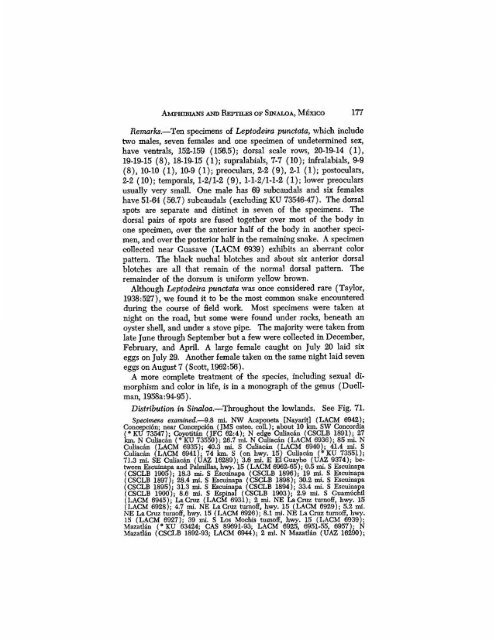The Amphibians and Reptiles of Sinaloa, Mexico - Smithsonian ...
The Amphibians and Reptiles of Sinaloa, Mexico - Smithsonian ...
The Amphibians and Reptiles of Sinaloa, Mexico - Smithsonian ...
You also want an ePaper? Increase the reach of your titles
YUMPU automatically turns print PDFs into web optimized ePapers that Google loves.
AMPHIBIANS AND REPTILES OF SINALOA, MEXICO 177<br />
Remarks.—Ten specimens <strong>of</strong> Leptodeira punctata, which include<br />
two males, seven females <strong>and</strong> one specimen <strong>of</strong> undetermined sex,<br />
have ventrals, 152-159 (156.5); dorsal scale rows, 20-19-14 (1),<br />
19-19-15 (8), 18-19-15 (1); supralabials, 7-7 (10); infralabials, 9-9<br />
(8), 10-10 (1), 10-9 (1); preoculars, 2-2 (9), 2-1 (1); postoculars,<br />
2-2 (10); temporals, 1-2/1-2 (9), 1-1-2/1-1-2 (1); lower preoculars<br />
usually very small. One male has 69 subcaudals <strong>and</strong> six females<br />
have 51-64 (56.7) subcaudals (excluding KU 73546-47). <strong>The</strong> dorsal<br />
spots are separate <strong>and</strong> distinct in seven <strong>of</strong> the specimens. <strong>The</strong><br />
dorsal pairs <strong>of</strong> spots are fused together over most <strong>of</strong> the body in<br />
one specimen, over the anterior half <strong>of</strong> the body in another specimen,<br />
<strong>and</strong> over the posterior half in the remaining snake. A specimen<br />
collected near Guasave (LACM 6939) exhibits an aberrant color<br />
pattern. <strong>The</strong> black nuchal blotches <strong>and</strong> about six anterior dorsal<br />
blotches are all that remain <strong>of</strong> the normal dorsal pattern, <strong>The</strong><br />
remainder <strong>of</strong> the dorsum is uniform yellow brown.<br />
Although Leptodeira punctata was once considered rare (Taylor,<br />
1938:527), we found it to be the most common snake encountered<br />
during the course <strong>of</strong> field work. Most specimens were taken at<br />
night on the road, but some were found under rocks, beneath an<br />
oyster shell, <strong>and</strong> under a stove pipe. <strong>The</strong> majority were taken from<br />
late June through September but a few were collected in December,<br />
February, <strong>and</strong> April. A large female caught on July 20 laid six<br />
eggs on July 29. Another female taken on the same night laid seven<br />
eggs on August 7 (Scott, 1962:56).<br />
A more complete treatment <strong>of</strong> the species, including sexual dimorphism<br />
<strong>and</strong> color in life, is in a monograph <strong>of</strong> the genus (Duellman,<br />
1958a: 94-95).<br />
Distribution in <strong>Sinaloa</strong>.—Throughout the lowl<strong>and</strong>s. See Fig. 71.<br />
Specimens examined.—9.8 mi. NW Acaponeta [Nayarit] (LACM 6942);<br />
Concepci6n; near Conception (JMS osteo. coll); about 10 km. SW Concordia<br />
("KU 73547); Coyotitan (JFC 62:4); N edge Culiacan (CSCLB 1891); 27<br />
km. N Culiacan (* KU 73550); 26.7 mi. N Culiacan (LACM 6936): 85 mi. N<br />
Culiacan (LACM 6935); 40.3 mi. S Culiacan (LACM 6940); 41.4 mi. S<br />
Culiacan (LACM 6941); 74 km. S (on hwy. 15) Culiacan ('KU 73551);<br />
71.3 mi. SE Culiacan (UAZ 16289); 3.6 mi. E ElGuaybo (UAZ 9374); between<br />
Escuinapa <strong>and</strong> Palmillas, hwy. 15 (LACM 8962-65); 0.5 mi. S Escuinapa<br />
(CSCLB 1905); 18.3 mi. S Escuinapa (CSCLB 1896); 19 mi. S Escuinapa<br />
(CSCLB 1897); 28.4 mi. S Escuinapa (CSCLB 1898); 30.2 mi. S Escuinapa<br />
(CSCLB 1895); 31.3 mi. S Escuinapa (CSCLB 1894); 33.4 mi. S Escuinapa<br />
(CSCLB 1900); 8.6 mi. S Espmal (CSCLB 1903); 2.9 mi. S Cuamuchil<br />
LACM 6945); La Cruz (LACM 6931); 2 mi. NE La Cruz tum<strong>of</strong>f, hwy. 15<br />
(LACM 6928); 4.7 mi. NE La Cruz tum<strong>of</strong>f, hwy. 15 (LACM 6929); 5.2 mi.<br />
NE La Cruz tum<strong>of</strong>f, hwy. 15 (LACM 6926); 8.1 mi. NE La Cruz tum<strong>of</strong>f, hwy.<br />
15 (LACM 6927); 39 mi. S Los Mocbis tum<strong>of</strong>f, hwy. 15 (LACM 6939);<br />
Mazatlan ("KU 63424; CAS 89691-93; LACM 6925, 6951-55, 6957); N<br />
Mazadan (CSCLB 1892-93; LACM 6944); 2 mi. N Magadan (UAZ 16290);
















